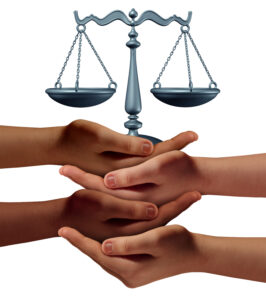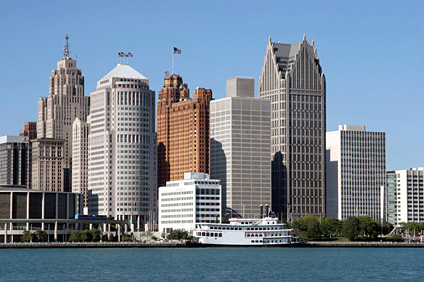Contents
- What Is the Purpose of Bankruptcy in US Law?
- What Is Social Justice in the Bankruptcy Context?
- The Current State of Consumer Bankruptcy
- Student Loan Non-Dischargeability
- An Avalanche of Medical Debt
- The Adversarial Nature of the Bankruptcy Process Itself
- Bankruptcy as a Tool for Social Justice: The Bottom Line

When enough people find their way out of debt, social change can occur. If you are struggling in financial hardship in Michigan, Chapter 7 or Chapter 13 bankruptcy will, in most cases, help you.
Bankruptcy is often seen as a last resort for those in financial distress, but it can also be a tool for social justice. In a country where economic inequality is a growing problem, consumer bankruptcy can help level the playing field for those who are struggling financially.
By providing a way out of debt cycles and helping consumers keep their assets, bankruptcy can help reduce poverty and economic inequality. Furthermore, bankruptcy can be a tool for reducing wealth disparities among different races and genders.
This Article explores the role of consumer bankruptcy in Michigan as a force for social justice and the ways in which it can help promote a more equitable society.
First, a basic question, however.
What Is the Purpose of Bankruptcy in US Law?
Consumer bankruptcy is a Federal legal process that allows individuals or families to reorganize or discharge their debts. A Chapter 7 or Chapter 13 bankruptcy case is adjudicated in and overseen by the Federal court system. In Detroit, for instance, bankruptcy cases are filed with the Eastern District of Michigan Bankruptcy Court in downtown Detroit—even if you live in Macomb or Oakland County.
The purpose of consumer bankruptcy in US law is twofold:
- To provide relief to debtors who are unable to pay their debts; and
- To provide a fair and orderly process for creditors to collect on their debts.
Beyond that, bankruptcy serves a macro-economic purpose. That is, a larger economic purpose, beyond your own interests, in terms of your own debt burden, and the interests of your particular creditors.
That purpose is to ensure that the US economy is robust. Bankruptcy ensures that people have enough disposable income to spend on goods and services, both necessary and unnecessary. Purchase of these goods and services keeps businesses running and keeps people employed.
You’ll notice that we haven’t mentioned social justice as a purpose of the US bankruptcy system. This is because social justice is an effect of bankruptcy and not its fundamental purpose.
That doesn’t make the social justice effect of bankruptcy any less important.
What do we mean, however, by “social justice?”
What Is Social Justice in the Bankruptcy Context?
Social justice in the legal context refers to the idea that the law should ensure fairness and equality for all people, regardless of social status, race, gender, or other personal characteristics. Social justice is an essential component of a just and democratic society. Internationally, it is considered a fundamental principle of a functional and fair legal system.
In a day-to-day context, social justice ensures that those involved in legal proceedings in the United States are not discriminated against on the basis of their social status, race, age, gender, or other personal characteristics. Social justice further requires that the law be used to promote the well-being of all individuals and to address social inequalities.
Social justice, on a societal level, also addresses systemic issues that lead to social inequalities.
For example, in the criminal justice system, social justice requires addressing issues such as racial bias, police brutality, and the overrepresentation of certain communities in the criminal justice system.
In the civil justice system, where consumer bankruptcy sits, social justice addresses issues such as access to justice for marginalized communities. It also ensures that the legal system is not prohibitively expensive or complicated for those who cannot afford legal representation.
Does our bankruptcy system accomplish any of these goals?
The Current State of Consumer Bankruptcy
As of this writing, the consumer bankruptcy process in the United States appears to be diminishing as a force for social justice.
This may be true for a few different reasons.
First, consumer bankruptcy filings are down dramatically. In 2021, consumer bankruptcy filings decreased 12% from the prior year. In 2022, they decreased another 6.3%.
In 2022, 225,455 Chapter 7 bankruptcy cases were filed in the U.S, and 157,087 Chapter 13 bankruptcy cases were filed.
In 2021, 288,327 Chapter 7 cases were filed while only 120,002 Chapter 13 cases were filed.
The COVID pandemic is likely one reason why filing numbers are down. However, in 2019, during the initial outbreak of the pandemic, 480,206 Chapter 7 cases were filed. COVID thus only partially explains the decrease.
It is more likely that the word has gotten around that bankruptcy is failing to truly provide people in need and those in under-represented segments of the United States with the truly fresh start that it is supposed to provide.
Why?
Student Loan Non-Dischargeability
Chapter 7 and Chapter 13 bankruptcy are not great at dealing with student loan debt. We have written about student loan debt and bankruptcy in other posts on this blog. However, for present purposes, it is a fact that it is highly difficult to discharge debt in Chapter 7 and Chapter 13 bankruptcy.
Unless you can prove by way of an expensive “adversary proceeding” lawsuit that your debt is either a non-educational expense or an “undue burden,” you will not discharge your student loans in bankruptcy. This is as true for private student loans as for government subsidized student loans. (An “undue burden,” here in Michigan, in the Sixth Circuit Court of Appeals is defined under the impossible Brunner Test, a legal test wholly invented by Federal Court judges.
It must be noted that Federal court judges are largely wealthy, white, and come from corporate-friendly “big law” backgrounds. The diversity of the Federal bench is improving, slowly, thanks to President Biden’s recent slate of nominees, but the Brunner Standard remains firmly in place in the Sixth Circuit. It must also be noted that few of even President Biden’s recent nominees come from a background of public rather than corporate service.)
Meanwhile, 45 million Americans suffer from the burden of student loan debt. According to NerdWallet, women, further, tend to borrow more than men do to fund their educations. Black students borrow more often and in greater amounts compared with members of other groups and ethnicities.
An Avalanche of Medical Debt
Chapter 7 and Chapter 13 bankruptcy are great at dealing with medical debt. Medical debt, in bankruptcy, is classified as non-priority unsecured debt. That is, it is entirely dischargeable. It is, further, easy to discharge in bankruptcy given that a person almost has never incurred medical debt “fraudulently.”
Fraud is one of these bases for a finding that a debt is non-dischargeable in bankruptcy. A creditor alleging that you received cancer treatments fraudulently would be laughed out of Bankruptcy Court.
Nevertheless, bankruptcy is not an easy process. And it is good for dealing with the debt you have today and not necessarily the debt you will have tomorrow.
If you do suffer from a congenital or long-term or recurring health condition, a bankruptcy will wipe the slate clean for you—and then do nothing to help you after that. You can only file Chapter 7 bankruptcy once every 8 years. You can only receive a discharge in a Chapter 13 bankruptcy once every 4 years.
With an ongoing or new medical condition, in this country, comes new medical debt. Always.
45% of Americans, or 1 in 4 of us, shoulder medical debt. $88 billion in medical debt weigh down American credit reports, according to the Consumer Financial Protection Bureau (CFBP). 19% of Americans with medical debt could not afford to pay it, reported the US Census Bureau in 2021.
Further, the Census Bureau reported that 27.9% of Black households carried medical debt versus 17.2% of White households. Households with a Hispanic member were more likely (21.7% to 18.6%) to carry medical debt than households without.
Of no surprise to any parent, households with children are also significantly more likely to carry burdensome medical debt.
Lower income families, naturally, are also far more likely to carry medical debt than higher income families.
Our healthcare system is purposefully confusing and bureaucratic, and it is devoted entirely to maximizing the shareholder profits of private healthcare corporations. Medical service providers are quick to refer even small past-due balances to collection agencies, who still have, as an industry, serious problems complying with even the weak constraints imposed by the Fair Debt Collections Practices Act or Michigan collections law.
Medical debt is a nonstop snowball, in other words, that never stops rolling across US consumers. Bankruptcy may discharge that debt effortlessly—but, as a process, it simply can’t keep up with the shocking inadequacies of our for-profit healthcare system.
The Adversarial Nature of the Bankruptcy Process Itself
The bankruptcy process itself is not cost-free for those seeking debt relief. We don’t mean the cost of hiring an experienced Michigan bankruptcy attorney to guide you through the process. Nor do we mean the filing fees charged by the US Bankruptcy Court to file a Chapter 7 or Chapter 13 case, adversary proceedings, and various motions.
We mean the cost of property liquidation in Chapter 7 bankruptcy. We mean the cost of Chapter 13 payment plans under the supervision of an aggressive Chapter 13 Trustee.
The extent to which the interests of creditors are favored in the US bankruptcy process has a tendency to tilt in their well-moneyed favor.
Does this mean that bankruptcy is a poor tool in the quest for social justice?
No.
Bankruptcy as a Tool for Social Justice: The Bottom Line
The bottom line is that bankruptcy was not designed to function as a tool for social justice. It is limited by the statutory deference to creditors built into the process. It is limited by the pressure of economic forces outside of bankruptcy, such as the cost of our (lack of a) national healthcare system.
Yet—for you, it may not feel this way.
If you are struggling in financial hardship in Michigan, Chapter 7 or Chapter 13 bankruptcy will, in most cases, help you.
It will help your friend, your co-worker, your neighbor, your grandmother … It is an equal opportunity force for decreasing economic inequality on a micro-level.
When enough people find their way out of debt, social change can occur. The trick with consumer bankruptcy is and will be to convince our legislators to recognize the ways in which bankruptcy can be a more relevant force for social justice and then to make those changes in law.
If you are considering filing for bankruptcy in Metro Detroit and have questions about the utility of the process within our economic, legal, and social system, you need the counsel of an experience Michigan bankruptcy attorney.
Attorney Walter Metzen is a Board Certified Bankruptcy Expert who has successfully represented thousands of Metro Detroit Chapter 7 and Chapter 13 for over 30 years.
Contact us now to schedule your free initial consultation.




